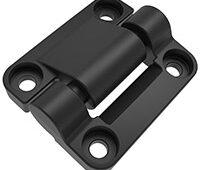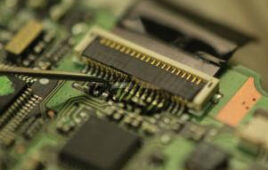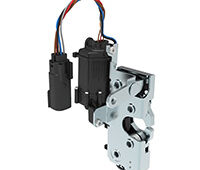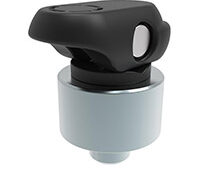By Adam Pratt
Adam Pratt is Vice President, Sherex Fastening Solutions
Blind rivet nuts first appeared on airplanes in the mid 1930’s. OEMs and equipment builders in the aerospace and military markets used them for airplane wing attachment in locations that limited access to one side of the structure. Over the course of seven decades, they outgrew this niche market and gained popularity in general industry because of their many design and assembly advantages.
A rivet nut is a one-piece mechanical fastener with a threaded hole. They have many functions. Rivet nuts provide access to an internally threaded nut in a workpiece where one side is inaccessible so that you can mount a secondary, removable piece to the material. A mating bolt or screw completes the assembly. They are primarily used to install threads in thin sheet metal or composites that are too thin for tapped threads. 
Rivet nuts come in a variety of materials, head styles, and finishes. Since corrosion is a key factor for proper joint function, the application’s environment will determine which rivet nut style, material, and surface finish is appropriate.
Rivet nuts attach roof racks to vehicles, blowers to the base pans in HVAC systems, and grab handles and gauges in boats. OEMs in the automotive, marine, food equipment, and military industries use rivet nuts when their applications require captive threaded fasteners.
Many factors influence their proper selection. You must know the specified hole size, joint strength, and so forth required for your assembly. What’s more, you must consider the environment in which the assembly will operate. Matching the rivet nut with the application’s environment is critical for proper joint design. Corrosive environments can deteriorate a joint so that it is almost impossible to service because of binding threads. Material loss from corrosion can also reduce the clamp load of the joint, which makes it more likely to loosen or fail. The application’s environment will determine which rivet nut style, material, and surface finish you select.
Four standard materials protect rivet nut fasteners from corrosive environments. They include stainless steel, aluminum, and sacrificial finishes on steel.
Manufacturers typically make stainless steel rivet nuts in 430, 304, or 316 alloys. Rivet nuts are usually made in small runs from 430 stainless steel wire for military and aerospace applications to comply with the NAS 12730 specification. Most industrial applications today require 302/304 and 316 alloys because of their corrosion resistance and availability in the marketplace.

304 Stainless has the highest tensile and ultimate thread strength of the three most common materials used to produce rivet nuts. Tensile Strength in this case is the force required to tensile fracture the deformed section of the rivet nut. Ultimate Thread Strength is the force required to strip out the threads of the rivet nut after upset and when an axial force is induced on the thread
Engineers in the appliance, transportation, and fresh water marine industries tend to use 304 stainless steel rivet nuts. It is corrosion resistant and affordable. Alloying chromium and nickel with other materials yields the corrosion resistant properties of 304 stainless steel at about half the cost point of 316 stainless steel.
Molybdenum added to the basic components of 304, yields 316 stainless steel. It is the most corrosion resistant type in the stainless steel rivet nut product line and withstands chemical
environments where 304 is not recommended. For example, 316 has good resistance against corrosion in chloride based cleaning solutions. The chemical, food handling equipment, medical, and saltwater marine equipment industries typically use it.
Manufacturers also make corrosion resistant rivet nuts from either 5056 or 6061 aluminum grades with the option of an anodized finish for added corrosion protection. However, its low strength limits its use in load-bearing applications, and aluminum is subject to galvanic corrosion, making aluminum rivet nuts an unlikely choice in stainless steel panel applications.
The type of rivet nut fastener you select depends upon several factors, but the corrosion resistant properties of the rivet nut are critical for ensuring proper joint function. Zinc nickel electroplated steel has good corrosion resistance, as well as a cost point that is considerably lower than stainless steel. For applications that require more corrosion resistance, but do not contact food or chemicals, 304 stainless is a good choice. The best material applications requiring resistance to chemicals and food matter is 316 stainless steel.
Why are rivet nuts so popular?
If the back of your fastening material is unaccessable, rivet nuts may suit your application. They can be installed in designs where access to the joint is limited to one side.
They also have many other advantages. Rivet nuts
• are cost-effective;
• suit sheet metal, plastics, and tubular materials;
• do not damage surface finishes of galvanized or pre-painted materials;
• do not deform the target material;
• easily install into the base material with a hand tool;
• do not require heat or expensive presses for installation;
• are simple to assemble and disassemble;
• give strong loadbearing threads in material to 0.20 in. (0.5 mm);
• suit a wide range of material thicknesses.
Installation and principle of operation
To install a blind rivet nut, the user drills a hole into one material thickness. He then threads the rivet nut onto the mandrel of the installation tool and places it into the pre-drilled hole. After a slight upward motion of the tool, the mandrel retracts, and the body of the rivet nut collapses into the hole and forms a collar on the blind side of the workpiece. The user then removes the tool, aligns the second material to be joined, and secures a screw or bolt into the nut.

Rivet nut installation is a basically a three-step process. Step 1–The user drills a hole into the material. Step 2 –The mandrel on the installation tool attaches to the nut for insertion of the nut into the hole. Step 3– The mandrel disengages from the nut, which has now formed a collar on the blind side of the workpiece. Step 4 –The second material is set into place and a screw or bolt completes the assembly.
Electrodeposition of alloys yields high corrosion resistance
Because of improvements in electroplating alloys, manufacturers now use base steel with an electroplated surface finish in high corrosion applications. Typically, zinc is electrodeposited onto the surface of steel, followed by a layer of tin or nickel to increase corrosion resistance. Plating thicknesses vary from 8 to 15 µm. This sacrificial coating, or surface finish, corrodes before the steel, but at a much slower rate. Next, the surface finish corrodes, commonly called alloy corrosion (white rust). Once this process is complete, the base material begins to oxidize and produces red rust. Zinc nickel alloy electroplated rivet nuts have resisted red corrosion for more than 1000 hours in an accelerated corrosive environment when tested to ASTM B117 and SAE J2334 60 cycle specifications. What’s more, rivet nuts with zinc nickel alloy electroplating are 50 to 60% more cost
effective than stainless steel.

Researchers exposed four materials to a corrosive environment over a period of hours to determine which materials had the most corrosion resistance.
As a substitute for electrodepostion platings, the plating industry also commonly uses an extensive selection of Dip/Spin processes to finish fasteners. These processes involve coating fasteners in a solution, which typically comprises zinc and aluminum flakes, spinning them in a container to remove excess solution, and then curing the fasteners in an oven. The process is repeated 2 to 4 times and yields a coating thickness of 18 to 24 um. However, Dip/Spin is not recommended for rivet nuts because the thickness of the finish interferes with thread fit. It also has poor adhesion during the installation process of the fastener.
Sherex Fastening Solutions, LLC
www.sherex.com
This article was intended to provide a brief overview of commercially available rivet nuts in the marketplace and the common characteristics of each. While other materials may yield higher
results in certain corrosive situations, they are not typically used in the manufacture of blind rivet nuts.
:: Design World ::
Filed Under: FASTENING • JOINING • locks • latches • pins





Tell Us What You Think!